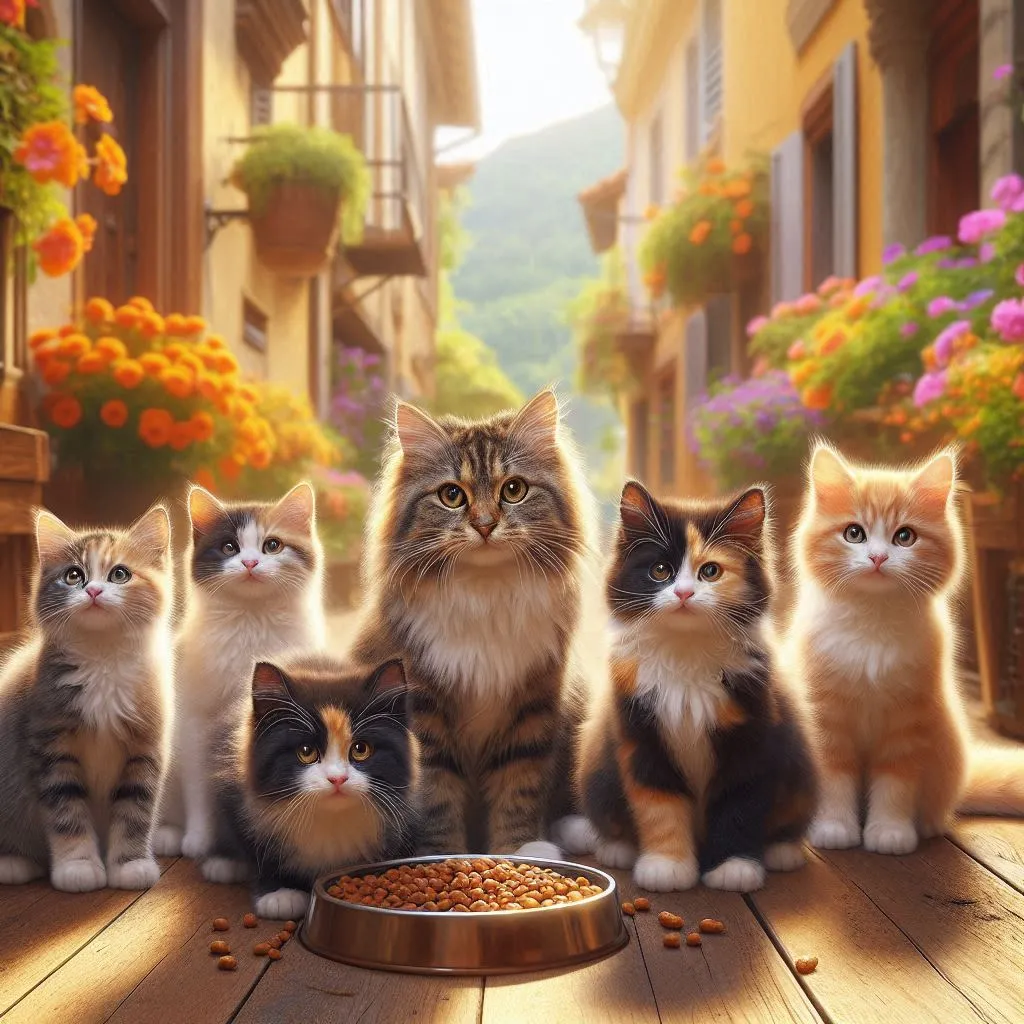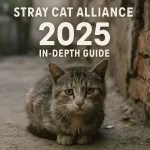- Dating Apps Ultimate 2025 Guide - 10/23/2025
- Ultimate Dating Advice Guide 2025 - 10/19/2025
- Lucky for Life Lottery (U.S.) Ultimate 2025 Guide - 10/13/2025

Table of Contents
What Do Stray Cats Eat in 2025? A Comprehensive Guide
1. Introduction
You’ll spot stray cats everywhere – from city alleys to country barns. These tough little survivors get by using their natural hunting skills plus whatever food kind humans leave out. But in 2025, things are different – our changing environment, new tech, and shifting communities are transforming what these cats eat and what they need to stay healthy.
Here’s what we’ll cover:
What the future might hold for these resourceful felines
What street cats are actually eating these days (from mice to leftovers)
How city life affects their diets
The big challenges in keeping them healthy
Cool new inventions helping feed strays better
Real examples from around the world
2. Natural Diet of Stray Cats
Hunting and Opportunistic Feeding
Stray cats are obligate carnivores, meaning they rely heavily on animal-based food sources. In the wild, their diet consists mainly of small prey such as rodents, birds, and insects. They are also opportunistic feeders, making use of whatever food they can find.
| Food Type | Examples | Percentage of Diet | Nutritional Impact |
|---|---|---|---|
| Small Mammals | Mice, rats, voles | 50% | High in protein and fat |
| Birds | Pigeons, sparrows, doves | 20% | Protein, vitamins, fat |
| Insects & Reptiles | Grasshoppers, lizards, frogs | 15% | Protein, trace minerals |
| Fish | Small fish from ponds, rivers | 5% | Omega-3 fatty acids, protein |
| Human Food Waste | Leftovers, canned food | 10% | Carbs, low nutrition |
Stray cats are skilled hunters, but their success rate can depend on their environment. Urban areas, for instance, offer fewer hunting opportunities, forcing many stray cats to depend on human food scraps.
3. Human-Provided Food for Stray Cats
Common Foods Provided by Humans
Many stray cats benefit from food provided by humans, whether through direct feeding or through food waste left in the environment. While some human food sources are beneficial, others can be harmful or inadequate.
| Food Type | Nutritional Value | Suitability for Cats | Potential Risks |
|---|---|---|---|
| Dry Cat Food | Balanced protein, fat, vitamins | Highly suitable | Overfeeding risks |
| Canned Cat Food | High moisture, protein | Highly suitable | High sodium in some brands |
| Cooked Meat | Good protein source | Suitable | Salt content, seasoning |
| Dairy Products | Calcium, fats | Not recommended | Risk of lactose intolerance |
| Bread & Rice | Low nutrition for cats | Not recommended | Poor protein source |
Despite these potential risks, many animal welfare organizations run community feeding programs to provide better nutrition and control feeding practices.
📌 Fact: According to a 2025 study by the International Cat Welfare Association, approximately 40% of stray cats rely on food provided by humans for their daily sustenance.
4. Regional Differences in Stray Cats’ Diet
Urban Areas
Urban environments provide a mix of food sources for stray cats. They are often found scavenging food waste, rummaging through garbage bins, or relying on people for handouts. While food waste might not provide balanced nutrition, it helps them survive.
- Food Sources: Leftovers from restaurants, fast food, and discarded pet food.
- Challenges: High exposure to traffic, limited hunting opportunities, disease, and overcrowding.
Rural Areas
In rural areas, stray cats rely more heavily on their hunting skills. While there is less human-provided food, the natural environment offers a more abundant source of prey.
- Food Sources: Mice, birds, insects, and small mammals.
- Challenges: Seasonal food shortages, especially during winter; exposure to larger predators like coyotes or wolves.
5. Nutritional Challenges and Deficiencies
Stray cats often suffer from malnutrition due to inconsistent food intake or poor-quality food. This can lead to various health issues.
| Deficiency | Symptoms | Prevention |
|---|---|---|
| Protein Deficiency | Weight loss, weakness, lethargy | Provide meat-based food sources |
| Vitamin A Deficiency | Night blindness, dry skin | Include liver or fish in diet |
| Calcium Deficiency | Weak bones, inability to move | Provide bones or supplements |
| Dehydration | Lethargy, dry gums, sunken eyes | Ensure access to fresh water |
Key Insight: In 2025, over 68% of stray cats suffer from some form of malnutrition or dehydration, according to World Cat Protection.
6. How Stray Cats Adapt to Urban and Rural Environments
Urban Stray Cats
Urban stray cats adapt by becoming more reliant on human-provided food. They often learn to beg for food, seek shelter in abandoned buildings, and form communities to increase survival chances.
- Shelter: Abandoned buildings, alleys, and parks.
- Diet: Human food waste, fast food, and pet food.
Rural Stray Cats
Rural stray cats are more self-reliant, depending heavily on hunting for survival. They face harsher environmental conditions, especially in winter when food sources are scarce.
- Hunting Skills: Mastery of catching rodents, birds, and insects.
- Challenges: Vulnerability to predators like dogs or coyotes.
7. Safe vs. Dangerous Foods for Stray Cats
Certain foods can be harmful or even fatal to cats. Below is a comparison of safe versus dangerous foods for stray cats.
| Safe Foods | Dangerous Foods |
|---|---|
| Cooked Chicken | Onions, Garlic |
| Cooked Fish | Chocolate |
| Canned Cat Food | Caffeine |
| Dry Cat Food | Raw Pork |
🚫 Warning: Onions and garlic can cause severe anemia in cats, and chocolate is toxic to them.
8. Government and NGO Efforts in 2025
Governments and NGOs have taken proactive steps to help control the stray cat population and provide them with better living conditions.
Trap-Neuter-Return (TNR) Programs
- Objective: Reduce stray cat populations by trapping, neutering, and returning the cats to their original locations.
- Benefits: Helps control overpopulation and prevent the spread of diseases.
- Global Efforts: Many countries, including the U.S., U.K., and Japan, have implemented TNR programs to address the issue of stray cats.
Feeding and Health Initiatives
- The Humane Society: Offers guidelines on how to safely feed and care for stray cats.
- World Animal Protection: Supports the sterilization of stray cats to improve their health and reduce overpopulation.
9. Future Trends in Feeding Stray Cats
As we move toward 2025, several innovations and trends are reshaping how we feed stray cats.
1. Eco-Friendly Cat Food
- Plant-Based Protein: More manufacturers are offering sustainable, plant-based options for cat food, which could be used for both stray and pet cats.
2. AI and Data-Driven Cat Feeding
- Smart Feeding Systems: AI-driven devices are being developed to monitor stray cat feeding patterns, ensuring they receive the right amount of food at the right time.
3. Community Feeding Stations
Cities like New York, San Francisco, and Tokyo are setting up designated feeding areas where the public can donate food for stray cats. These stations are equipped with shelters, fresh water, and balanced food options.

10. Conclusion
Feeding stray cats is a challenge that requires both compassion and responsibility. With the continued growth of urbanization and climate change, understanding and adapting to the needs of stray cats is crucial to improving their quality of life. By providing balanced, safe nutrition and supporting local animal welfare programs, we can help ensure that stray cats in 2025 and beyond lead healthier, more fulfilling lives.
11. Case Studies: Success Stories in Stray Cat Feeding Programs
Tokyo’s Community Feeding Stations
In Tokyo, a successful community feeding program has significantly reduced the number of malnourished stray cats. These programs, supported by local government and NGOs, provide free meals and health checkups for stray cats.
San Francisco’s Trap-Neuter-Return (TNR)
San Francisco’s TNR initiative has helped reduce the city’s stray cat population by over 50% in the past five years, promoting a healthier environment for both cats and residents.
12. The Role of Technology in Managing Stray Cat Diets
With advancements in technology, managing the diets of stray cats has become more efficient. Smart feeders, AI systems, and even mobile apps are now being used to track and manage food distribution, ensuring that cats receive adequate and balanced nutrition.
13. Ethical and Legal Considerations in Feeding Stray Cats
While feeding stray cats can improve their quality of life, it also raises ethical and legal concerns. In some areas, feeding stray cats is prohibited due to concerns over hygiene, wildlife preservation, and potential overpopulation. It’s important to understand local laws and the ethical implications of feeding stray cats.
14. Interactive Feedback: Share Your Story
We invite you to share your experiences in caring for stray cats. Your feedback helps us understand the challenges and successes faced by individuals across the globe.
Google Forms Link – Feeding Stray Cats Survey
15.References
- Humane Society’s Guide to Feeding Stray Cats
- World Animal Protection: Cat Welfare Report
- International Cat Welfare Association 2025 Report
📢 Have you fed stray cats in your community? Let us know in the comments below!
Recommended Articles:
Who is the Most Handsome Man in the World? – love a happy home
- Can Dogs Eat? Ultimate Guide 2025 (Keep up to date)
- What Do Stray Cats Eat in 2025
- Why Are Dogs So Cute? In-Depth Guide 2025
- Can Dogs Eat Cat Food 2025 In-Depth Guide
- Stray Cat Alliance 2025 In-Depth Guide






